Dinosaur Eggs from the Late Triassic Reveal Their Contents
Researchers from the University of Witwatersrand (Johannesburg, South Africa), have utilised the high-powered and intense energy of the European Synchrotron Radiation Facility (ESRF), located at Grenoble in France to unscramble the embryonic development of dinosaurs. The study, published in the journal “Scientific Reports”, demonstrates that dinosaur embryos show many similarities to the embryonic development of their living archosaurian relatives – birds and crocodiles. In addition, the scientists found that in the dinosaur studied (the Sauropodomorpha Massospondylus carinatus), a set of simple teeth developed, in addition to the teeth the animal would have when it hatched.
Massospondylus carinatus
These simple teeth (null-generation teeth), were either reabsorbed into the jawbone or shed prior to the animal breaking out of the egg. This anatomical trait is found in crocodiles and lizards such as geckos (Order Squamata).
A Computer Generated Image of a Massospondylus Embryo Showing the Skull Bones
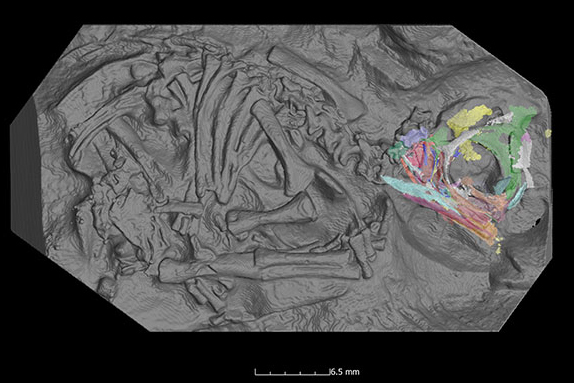
Picture credit: Dr Kimberley Chapelle (University of Witwatersrand)
Lizards are not members of the Archosauria, they are not closely related to dinosaurs (nor to birds or crocodiles for that matter), this suggests that the production of null-generation teeth that are lost prior to hatching is an embryonic trait which is basal within the Class Reptilia and that, in essence, the embryonic developmental pattern in reptiles was established early in their evolutionary history.
Digitally Reconstructing the Skulls of Baby Dinosaurs
In the study, led by Dr Kimberley Chapelle and Professor Jonah Choiniere of the Evolutionary Studies Institute, based at the University of Witwatersrand, three-dimensional, computer generated images were created of the less than 2 cm long skulls of the embryonic dinosaurs. The clutch of eggs was discovered in 1976 at a location within the Golden Gate Highlands National Park (Free State Province), the fossil specimens represent some of the oldest dinosaur eggs known to science.
The Clutch of Massospondylus Eggs Discovered in 1976 (Free State Province)
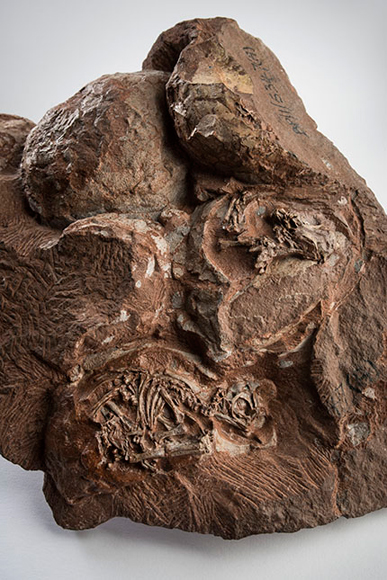
Picture credit: Brett Eloff
Amongst the Rarest of Dinosaur Fossils
The fossilised remains of dinosaur embryos are among the rarest of all vertebrate fossils. However, if palaeontologists can study them, then they can provide unique insights into the development of baby dinosaurs and permit comparison with the development of living archosaurs such as birds and crocodiles.
The powerful X-rays generated by the synchrotron allowed the researchers to obtain extremely detailed images of the fragile contents of the eggs, in what is a non-destructive technique. The study commenced in 2015, when the fossils were transported to the ESRF at Grenoble. It took nearly three years to process all the data generated back at the University, but the work was worth it as the scientists were able to reconstruct the delicate, tiny skulls of the dinosaurs in exquisite detail.
The fossil specimens were scanned at an unprecedented level of detail, the team were able to define and map individual cells within the fossilised bone.
Views from Various Angles of the Tiny Skull of a Massospondylus Embryo
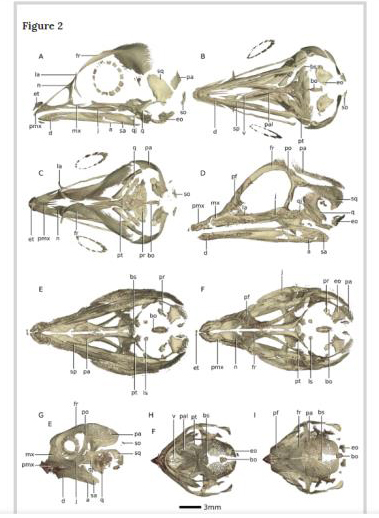
Picture credit: University of Witwatersrand/Scientific Reports
Working Out the Developmental Age of the Dinosaur Embryos
It had been thought that the fossilised Massospondylus eggs represented a clutch that had perished just prior to hatching. An analysis of the state of the skull bones and direct comparison with the development stages of crocodile, chicken, turtle and lizard embryos revealed that the Massospondylus embryos were much younger than previously thought. These dinosaur babies were only 60% of the way through their incubation. This makes them some of the ontogenetically youngest dinosaur embryos known. All other dinosaur embryos in the literature with ontogenetic age estimates are believed to represent dinosaurs in the last third of their development in the egg or close to hatching.
Hatching Massospondylus Dinosaurs in the Late Triassic of South Africa
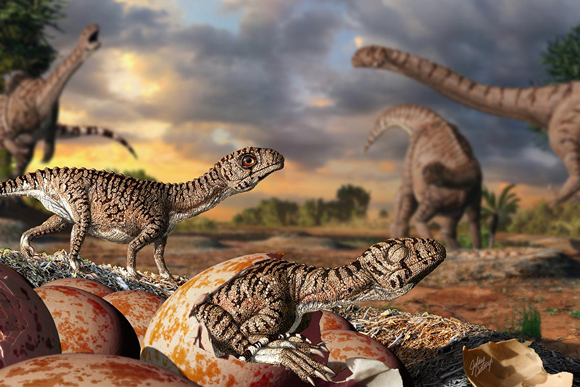
Picture credit: Julius Csotonyi
The Discovery of Null-generation Teeth in Dinosaur Embryos
Furthermore, the researchers discovered that each tiny embryo had two types of teeth preserved in its developing jaws. One set was very similar to the teeth associated with Massospondylus adults, the second set consisted of tiny, very simple triangular teeth that were either reabsorbed into the jaw or shed prior to hatching. These types of teeth are referred to as null-generation teeth and they are found in crocodilians and some types of extant lizard embryos such as geckos.
An Illustration of the Tooth Crowns of an Adult Massospondylus
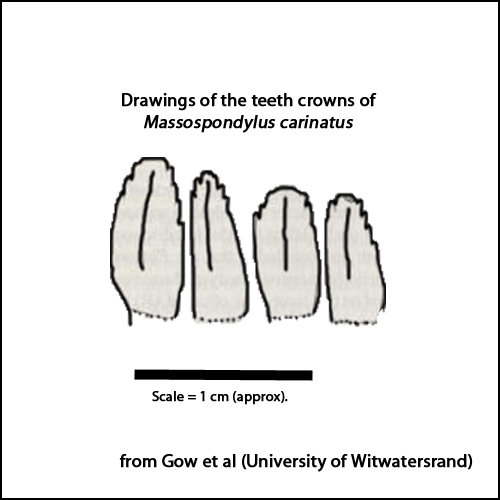
Picture credit: Everything Dinosaur from Gow et al (University of Witwatersrand)
Commenting on the discovery of null-generation teeth in the jaws of the dinosaur embryos, lead author, Dr Chapelle stated:
“I was really surprised to find that these embryos not only had teeth, but had two types of teeth. The teeth are so tiny, they range from 0.4 to 0.7 mm wide. That’s smaller than the tip of a toothpick!”
The scientists conclude that dinosaurs developed in their eggs in very similar ways as extant archosaurs, so what we know about the development of birds and crocodiles in the egg can be confidently applied to extinct archosaurs such as dinosaurs and pterosaurs too. The development traits shared with members of the Squamata Order (lizards and snakes) would permit these findings to be applied generally to a much wider variety of extinct reptiles, such as those assigned to the Lepidosauria clade, the sister clade to the Archosauria, reptiles on a different branch of the Reptilia family tree.
Synchrotron Analysis Likely to Lead to Further Insights into Dinosaur Development
The research team hope to utilise the thousands of scans they have amassed to better understand the post-cranial development of sauropod dinosaurs. They will be examining the rest of the skeleton of the Massospondylus embryos to see if this dinosaur shares similarities in development with extant archosaurs. The scientists hope to shed further light on how these dinosaurs moved about when they first emerged from the nest. Palaeontologists think that these types of dinosaurs hatched as bipeds before adopting a quadrupedal stance as these animals grew and matured.
Everything Dinosaur acknowledges the assistance of a media release from the University of Witwatersrand in the compilation of this article.
The scientific paper: “Conserved in-ovo cranial ossification sequences of extant saurians allow estimation of embryonic dinosaur developmental stages” by Kimberley E. J. Chapelle, Vincent Fernandez and Jonah N. Choiniere published in Scientific Reports.
Visit the Everything Dinosaur website: Everything Dinosaur.






Leave A Comment